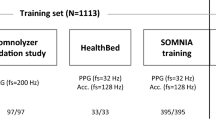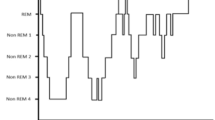Abstract
The work considers automatic sleep stage classification, based on heart rate variability (HRV) analysis, with a focus on the distinction of wakefulness (WAKE) from sleep and rapid eye movement (REM) from non-REM (NREM) sleep. A set of 20 automatically annotated one-night polysomnographic recordings was considered, and artificial neural networks were selected for classification. For each inter-heartbeat (RR) series, beside features previously presented in literature, we introduced a set of four parameters related to signal regularity. RR series of three different lengths were considered (corresponding to 2, 6, and 10 successive epochs, 30 s each, in the same sleep stage). Two sets of only four features captured 99 % of the data variance in each classification problem, and both of them contained one of the new regularity features proposed. The accuracy of classification for REM versus NREM (68.4 %, 2 epochs; 83.8 %, 10 epochs) was higher than when distinguishing WAKE versus SLEEP (67.6 %, 2 epochs; 71.3 %, 10 epochs). Also, the reliability parameter (Cohens’s Kappa) was higher (0.68 and 0.45, respectively). Sleep staging classification based on HRV was still less precise than other staging methods, employing a larger variety of signals collected during polysomnographic studies. However, cheap and unobtrusive HRV-only sleep classification proved sufficiently precise for a wide range of applications.




Similar content being viewed by others
References
Aktaruzzaman M, Sassi R (2014) Parametric estimation of sample entropy in heart rate variability analysis. Biomed Signal Process Control 14:141–147
Baselli G, Porta A, Rimoldi O et al (1997) Spectral decomposition in multichannel recordings based on multivariate parametric identification. IEEE Trans Biomed Eng 44:1092–1101
Berry RB, Budhiraja R, Gottlieb DJ et al (2012) Rules for scoring respiratory events in sleep: update of the 2007 AASM manual for the scoring of sleep and associated events. J Clin Sleep Med 8:597–619
Bianchi AM, Mendez MO, Cerutti S (2010) Processing of signals recorded through smart devices: sleep-quality assessment. IEEE Trans Inf Technol Biomed 14:741–747
Box GEP, Jenkins GM (1976) Time series analysis: forecasting and control, Revised edition. Holden-Day, San Francisco
Cohen J (1968) Weighted kappa: nominal scale agreement provision for scaled disagreement or partial credit. Psychol Bull 70:213–220
Covassin N, de Zambotti M, Cellini N et al (2013) Cardiovascular down-regulation in essential hypotension: relationships with autonomic control and sleep. Psychophysiology 50:767–776
Ebrahimi F, Setarehdan S-K, Ayala-Moyeda J, Nazeran H (2013) Automatic sleep staging using empirical mode decomposition, discrete wavelet transform, time-domain, and nonlinear dynamics features of heart rate variability signals. Comput Methods Progr Biomed 112:47–57
Engeda J, Mezuk B, Ratliff S, Ning Y (2013) Association between duration and quality of sleep and the risk of pre-diabetes: evidence from NHANES. Diabet Med J Br Diabet Assoc 30:676–680
Estrada E, Nazeran H (2010) EEG and HRV signal features for automatic sleep staging and apnea detection. In: 20th International Conference on Electronics Communications and Computer 142–147
Everitt BS, Dunn G (2010) Applied multivariate data analysis, 2nd edn. Wiley, Chichester
Ferini-Strambi L, Bianchi A, Zucconi M et al (2000) The impact of cyclic alternating pattern on heart rate variability during sleep in healthy young adults. Clin Neurophysiol 111:99–101
Kales A, Rechtschaffen A, Los Angeles University of California, et al. (1968) A manual of standardized terminology, techniques and scoring system for sleep stages of human subjects. US National Institute of Neurological Diseases and Blindness, Neurological Information Network, Bethesda, Md
Kondo H, Ozone M, Ohki N et al (2014) Association between heart rate variability, blood pressure and autonomic activity in cyclic alternating pattern during sleep. Sleep 37:187–194
Kortelainen JM, Mendez MO, Bianchi AM et al (2010) Sleep staging based on signals acquired through bed sensor. IEEE Trans Inf Technol Biomed 14:776–785
Kuna ST, Badr MS, Kimoff RJ et al (2011) An official ATS/AASM/ACCP/ERS workshop report: research priorities in ambulatory management of adults with obstructive sleep apnea. Proc Am Thorac Soc 8:1–16
Logue EE, Scott ED, Palmieri PA, Dudley P (2014) Sleep duration, quality, or stability and obesity in an urban family medicine center. J Clin Sleep Med 10:177–182
Malik M, Cripps T, Farrell T, Camm AJ (1989) Prognostic value of heart rate variability after myocardial infarction. A comparison of different data-processing methods. Med Biol Eng Comput 27:603–611
Malik M, Bigger JT, Camm AJ et al (1996) Heart rate variability standards of measurement, physiological interpretation, and clinical use. Eur Heart J 17:354–381
Mendez MO, Matteucci M, Castronovo V et al (2010) Sleep staging from heart rate variability: time-varying spectral features and hidden Markov models. Int J Biomed Eng Technol 3:246–263
Migliorini M, Bianchi AM, Nisticò D, et al. (2010) Automatic sleep staging based on ballistocardiographic signals recorded through bed sensors. In: Proceedings of the Annual International Conference of the IEEE Engineering in Medicine and Biology Society 2010:3273–3276
Peng C-K, Havlin S, Stanley HE, Goldberger AL (1995) Quantification of scaling exponents and crossover phenomena in nonstationary heartbeat time series. Chaos 5:82–87
Penzel T, Bunde A, Grote L et al (2000) Heart rate variability during sleep stages in normals and in patients with sleep apnea. Stud Health Technol Inform 77:1256–1260
Pizza F, Contardi S, Antognini AB et al (2010) Sleep quality and motor vehicle crashes in adolescents. J Clin Sleep Med 6:41–45
Redmond DSJ, de Chazal P, O’Brien C et al (2007) Sleep staging using cardiorespiratory signals. Somnologie Schlafforschung Schlafmed 11:245–256
Richman JS, Moorman JR (2000) Physiological time-series analysis using approximate entropy and sample entropy. Am J Physiol Heart Circ Physiol 278:H2039–H2049
Scholz UJ, Bianchi AM, Cerutti S, Kubicki S (1997) Vegetative background of sleep: spectral analysis of the heart rate variability. Physiol Behav 62:1037–1043
Sforza E, Pichot V, Barthelemy JC et al (2005) Cardiovascular variability during periodic leg movements: a spectral analysis approach. Clin Neurophysiol 116:1096–1104
Stanley N (2005) The physiology of sleep and the impact of ageing. Eur Urol Suppl 3:17–23
Terzano MG, Parrino L, Smerieri A et al (2002) Atlas, rules, and recording techniques for the scoring of cyclic alternating pattern (CAP) in human sleep. Sleep Med 3:187–199
Vaughn BV, Quint SR, Messenheimer JA, Robertson KR (1995) Heart period variability in sleep. Electroencephalogr Clin Neurophysiol 94:155–162
Vigo DE, Dominguez J, Guinjoan SM et al (2010) Nonlinear analysis of heart rate variability within independent frequency components during the sleep–wake cycle. Auton Neurosci 154:84–88
Xiao M, Yan H, Song J et al (2013) Sleep stages classification based on heart rate variability and random forest. Biomed Signal Process Control 8:624–633
Zamarrón C, Valdés Cuadrado L, Alvarez-Sala R (2013) Pathophysiologic mechanisms of cardiovascular disease in obstructive sleep apnea syndrome. Pulm Med 2013:521087
Zemaitytė D, Varoneckas G, Sokolov E (1984) Heart rhythm control during sleep. Psychophysiology 21:279–289
Zhou Z-H, Liu X-Y (2006) Training cost-sensitive neural networks with methods addressing the class imbalance problem. IEEE Trans Knowl Data Eng 18:63–77
Author information
Authors and Affiliations
Corresponding author
Rights and permissions
About this article
Cite this article
Aktaruzzaman, M., Migliorini, M., Tenhunen, M. et al. The addition of entropy-based regularity parameters improves sleep stage classification based on heart rate variability. Med Biol Eng Comput 53, 415–425 (2015). https://doi.org/10.1007/s11517-015-1249-z
Received:
Accepted:
Published:
Issue Date:
DOI: https://doi.org/10.1007/s11517-015-1249-z




